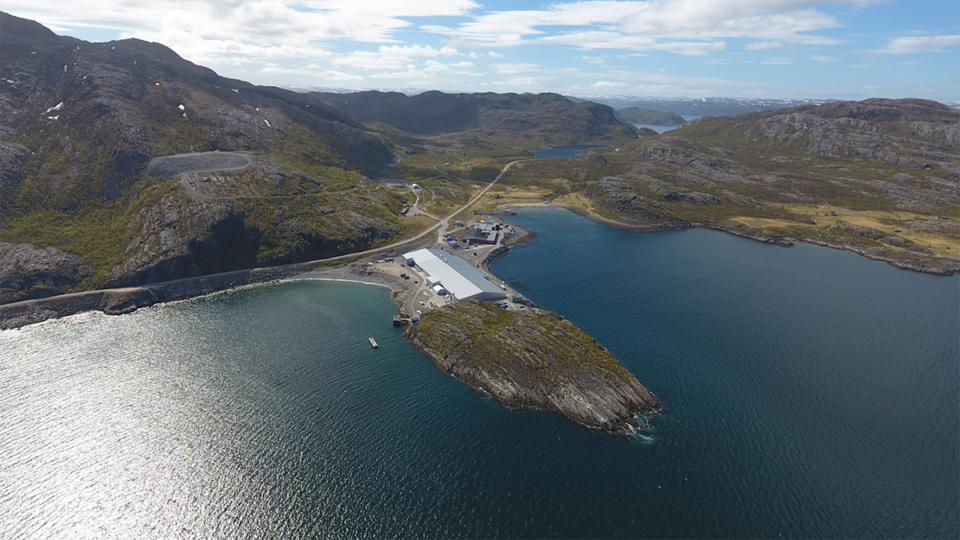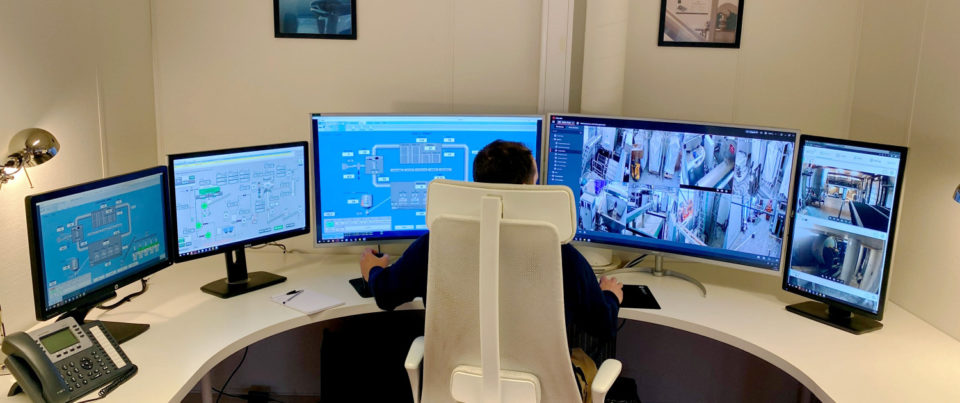Bioretur converts farmed fish sludge into a powder fertilizer as demand for ‘circular economy’ technologies grows

The intensification of aquaculture has led to more inputs and increased amounts of fish waste, or fish sludge, from production systems. For Norway’s world-leading farmed salmon sector, much of this waste is disposed of at sea, leading to concerns over eutrophication and the wasting of valuable nutrients such as nitrogen and phosphorus.
Thanks to new technology, fish farms are now in a better position than ever to dispose of their waste in innovative ways. One company that’s helping them achieve this is Norwegian firm Bioretur, which provides treatment plants and services to convert fish sludge into fertilizer.
“Our system cleans and dries fish sludge into 90 percent powder,” Bioretur CEO Steinar Wasmuth told the Advocate. “We also offer support services such as operation, transport, handling and processing. We create an approved product without any chemicals or hazardous byproducts.”
Bioretur’s system is installed only on land-based farms from smolt and post-smolt production to grow-out facilities. It uses hot air or frictional heat to dry sludge into a powder, which is then transported to a centralized facility and turned into fertilizer by Bioretur’s business partner Terramarine. The transportation and disposal of sludge can leave a huge carbon footprint, but because Bioretur removes the water beforehand, there is very little mass to transport. An electric train is used from locations far north of Norway to reduce carbon footprint further.
https://www.aquaculturealliance.org/advocate/recovering-nutrients-seafood-processing-water/
Bioretur focuses on delivering equipment that meets cleaning requirements and proves cost-effective and sustainable. Incremental development of technology is done continuously. All systems are remotely controlled from Bioretur’s control room and don’t require any operation or maintenance from fish farm staff.
Wasmuth established Bioretur in 2015 when he was unable to dispose of manure from a horse riding center on his farm. Around a ton of manure was produced each day but it could not be used as fertilizer because it was mixed with wood shavings and wood chips from the horse boxes. After much exploration and testing, Wasmuth found that replacing the wood shavings with a wheat straw converted the manure into a good fertilizer. As work progressed, he was approached by land-based fish farms looking for an efficient way to dispose of their waste.
“Our customers pay a monthly fee for technical operations and handling of the sludge,” said Wasmuth. “Our goal is to take the problem away from them and let them focus on producing good fish while knowing that their sludge is being taken care of in the best way possible.”

Bioretur is also helping other countries such as Vietnam meet their need for fertilizer.
“We transport dried sludge to Stavanger where it’s made into fertilizer,” said Wasmuth. “From there we work with a company that delivers it to Vietnam, where an extensive, over-consumption of fertilizer has resulted in soil depletion. Farmers use the fertilizer to produce various products, one of which is coffee that is sold across Asia. We are not part of the selling process, but we offer the coffee to our customers, who are then free to give it to their customers. In this way our customers can show that sludge from their farm is being put to good use.”
With fish farms under strict requirements from authorities on how to handle sludge, Bioretur’s system is key. It reduces the waste of valuable nutrients, minimizes marine pollution and enables farms to shrink their carbon footprint. Grieg Seafood Finnmark in Norway produces between 20 to 200 tons of dried fish sludge each year. According to Global Sustainability Advisor Jostein Iversen, proven, reliable and effective waste treatment systems are essential for post-smolt and land-based production to ensure growth and provide aquaculture with the tools for sustainable fish farming.
“Bioretur has a sound business model with technical solutions that fit our needs,” said Iversen. “We found it interesting that they operate the installed equipment for us as we initially wanted to outsource the treatment of our waste but our smolt facility in Finnmark, northern Norway, is remote and relies heavily on road infrastructure. Transportation would be costly with high greenhouse gas emissions. Bioretur also has good water-separating technology – hypersonic flocculation – that removes the need for polymer consumption. This was important to us as the use of polymers as a flocculant has a footprint that must be taken into account.”
The linear way in which waste is being managed today isn’t sustainable and is in need of a renaissance.
Grieg Seafood’s Atlantic salmon farm in Newfoundland, Canada, has Bioretur’s systems on their smolt and post-smolt facilities. Managing Director Knut Skeidsvoll said both consume little energy and are easy to operate because they are fully automatic. Meanwhile, the absence of chemicals eliminates environmental issues and online training has enabled an easy set-up.
“Because of the high efficiency of our RAS system, we needed something that didn’t use any chemicals as treatment for dewatering and would re-use the water once it had been run through the system,” Skeidsvoll explained. “Bioretur was the only company that could meet these requirements. It’s also able to offer partial maintenance from Norway, which makes the process extremely smooth.”
Skeidsvoll added that recognizing value in what is considered waste will undoubtedly lead to better results for Grieg Seafood. There is also another benefit: improved employee satisfaction – particularly among younger workers – from working for a company that places “eco-friendly” at the forefront of its operations.
With other companies and fish farms keen to present themselves in this way, Wasmuth says that it’s important for them to understand how waste and byproducts from aquaculture can be transformed into something else, and the value of doing this. Making this clear will be key to gaining new customers, he said, along with pragmatic collaboration between regulators and businesses.
“The circular economy concept is growing,” said Iversen. “There are many initiatives being established as we speak. Soon EU regulations will be introduced, which will force Norway to take action. The linear way in which waste is being managed today isn’t sustainable and is in need of a renaissance.”
In Norway, although land-based smolt facilities are in plentiful supply, full grow-out systems on land are relatively new. But they could be key as the country’s salmon farming sector continues to grow. Land-based farms tend to be located where consumers are, which helps to reduce transportation and carbon footprint, and they are also committed to energy sources like renewable energy. This makes it possible to consider them within circular-economy business models.
Now, they have a chance to be part of a whole new economy around what is considered waste – a fitting opportunity amidst the demand for circularity and sustainability in industry.
“Systems like Bioretur’s will undoubtedly draw more attention,” said Skeidsvoll. “This is what has to happen, because if and when more land-based operations come into production, the volume of waste will be enormous, and a very efficient system will be needed to handle it. From a production point of view this is important, and it will also help us answer questions that will become tougher as time goes on.”
Follow the Advocate on Twitter @GAA_Advocate
Now that you've finished reading the article ...
… we hope you’ll consider supporting our mission to document the evolution of the global aquaculture industry and share our vast network of contributors’ expansive knowledge every week.
By becoming a Global Seafood Alliance member, you’re ensuring that all of the pre-competitive work we do through member benefits, resources and events can continue. Individual membership costs just $50 a year. GSA individual and corporate members receive complimentary access to a series of GOAL virtual events beginning in April. Join now.
Not a GSA member? Join us.
Author
-

Bonnie Waycott
Correspondent Bonnie Waycott became interested in marine life after learning to snorkel on the Sea of Japan coast near her mother’s hometown. She specializes in aquaculture and fisheries with a particular focus on Japan, and has a keen interest in Tohoku’s aquaculture recovery following the 2011 Great East Japan Earthquake and Tsunami.
Tagged With
Related Posts

Aquafeeds
It takes guts to advance sustainability in aquaculture
With byproducts representing between 25 to 50 percent of the weight of various fish species, we need to be looking at how the entire fish is being used: even the heads, guts and skin.

Responsibility
Repurposed: Adding value to aquaculture via recycling
With sustainability and environmental protection becoming increasingly prominent in Chile, recycling firms like Greenspot are drawing attention.

Responsibility
Can ranching ‘zombie urchins’ boost uni, save kelp forests?
With Norwegian knowledge and a partnership with Mitsubishi, Urchinomics aims to turn worthless empty urchins into valuable seafood while restoring kelp forests and creating jobs.

Aquafeeds
Waste not: Novel protein-recapture initiatives for aquaculture
A Norwegian fermentation technology firm utilizes volcanic matter to transform salmon waste, including feces and uneaten feed, into a high-protein powder.

